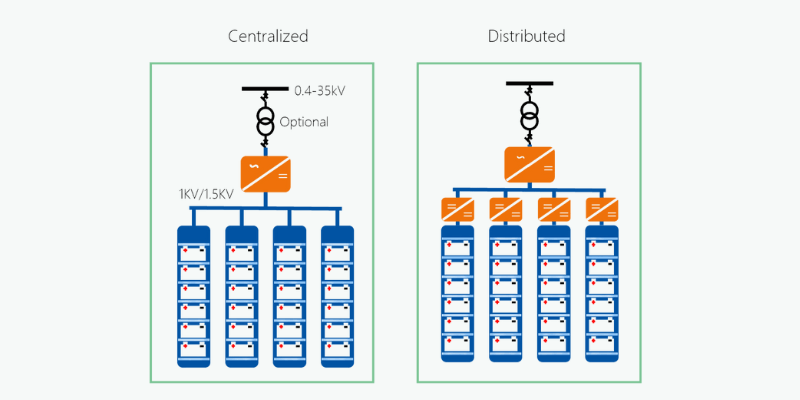لقد جعلت أزمة المناخ الطاقة المتجددة ضرورية، إلا أن التحول يمثل تحديات، لا سيما في مجال تخزين الطاقة. قبل اعتماد الطاقة المتجددة، تحتاج إلى البحث عن طرق تخزين فعالة، بما في ذلك الأنظمة الموزعة والمركزية. إن فهم اختلافاتهم وأدوارهم التكميلية أمر حيوي للاستفادة من التكنولوجيا المستدامة.
نظام تخزين الطاقة المركزي
يقوم نظام تخزين الطاقة المركزي (CESS) بتركيز الطاقة في مكان واحد. لاستخدام الطاقة المتجددة من مثل هذا النظام، يجب عليك توصيل منزلك أو عربة سكن متنقلة بشبكة تقوم بتخزين وتوزيع الطاقة الخضراء. تلتقط هذه التقنية الطاقة الزائدة خلال فترات انخفاض الطلب وتطلقها في أوقات الذروة.
هناك مزايا واضحة لاستخدام CESS:
- يمكن لشركات المرافق أن تستجيب بسرعة لحالات النقص أو الزيادات المفاجئة، مما يحافظ على استقرار الشبكة. على سبيل المثال، إذا كان أداء الألواح الشمسية ضعيفًا، فيمكن للشبكة المركزية توفير الطاقة الزائدة المخزنة.
- يستفيد التخزين المركزي من وفورات الحجم، مما يتيح عمليات واسعة النطاق وفعالة من حيث التكلفة.
ومع ذلك، هناك عيوب لCESS:
- تحدث خسائر الطاقة أثناء عمليات التخزين والاسترجاع، ويمكن أن تسبب طرق معينة مثل تخزين الطاقة الكهرومائية اضطرابات بيئية.
- يتطلب بناء البنية التحتية المركزية تكاليف أولية عالية ونفقات صيانة مستمرة، يتحملها المستهلكون في النهاية.
- يمكن للبنية التحتية المركزية أن تضر بالبيئة، وخاصة تخزين الطاقة الكهرومائية.
- يمكن تفكيك الأنظمة المركزية بسرعة وتكون بطيئة في التعافي من الكوارث الطبيعية.
على الرغم من هذه التحديات، يعد نظام تخزين الطاقة المركزي أمرًا بالغ الأهمية لتحقيق التوازن بين العرض والطلب في شبكات الكهرباء الحديثة مع دمج المصادر المتجددة، لكنه ليس الخيار الوحيد المتاح.
نظام تخزين الطاقة الموزعة
البديل للأنظمة المركزية هو الأنظمة الموزعة، والتي تتكون من وحدات صغيرة يتم تركيبها في مواقع مختلفة.
يستخدم نظام تخزين الطاقة الموزعة (DESS) عادةً بطاريات ليثيوم أيون لتخزين الطاقة بكفاءة. وهي تعمل بشكل جيد مع مصادر الطاقة المتجددة المحلية مثل الألواح الشمسية وتوربينات الرياح، وتلتقط الطاقة الزائدة لاستخدامها لاحقًا. وهذا يضمن كهرباء موثوقة حتى عندما تكون المصادر المتجددة غير نشطة.
في حين أن نظام DESS يعزز موثوقية الطاقة المحلية ويقلل الاعتماد على الشبكة المركزية، إلا أنه قد يكون لديه سعة تخزين محدودة مقارنة بالأنظمة المركزية.
يمكنك تنفيذ نظام هجين يلتقط الطاقة ويخزنها بشكل مستقل أثناء الاتصال بمصدر مركزي. إذا كنت تفضل الاستقلال الكامل، فيمكنك ضبط سعة التخزين الخاصة بك بناءً على المعدات الخاصة بك.
ومع ذلك، فإن عملية تعدين الليثيوم لتكنولوجيا البطاريات المتقدمة يمكن أن تسبب ضررًا بيئيًا. تأكد من فحص الموردين؛ تتعاون شركات مثل Holo Battery مع عمال مناجم الليثيوم المسؤولين الذين يتبعون أفضل الممارسات لتقليل التأثيرات البيئية.
خاتمة
يعد التحول إلى الطاقة المتجددة مفيدًا، لكن النجاح يعتمد على دمج البنية التحتية المناسبة لاحتياجاتك.
يمكن أن يوفر النهج المختلط استقلالية الطاقة مع إدارة المخاطر، كما تعتبر أنظمة تخزين الطاقة الموزعة مثالية لتطبيقات الهاتف المحمول. وأيًا كانت الطريقة التي تختارها، فإن البطاريات عالية الجودة والفعالة مهمة.
للحصول على بطاريات موثوقة، فكر في العمل مع إحدى الشركات المصنعة الكبرى مثل Holo Battery. تصمم Holo Battery حلول أيونات الليثيوم المتقدمة المناسبة للأنظمة الموزعة أو الهجينة، مما يضمن طول العمر والكفاءة. سيساعدك فريق خدمة العملاء المتميز في إعداد وصيانة نظام الطاقة الخاص بك لتلبية احتياجاتك بفعالية.
اتصل بـ Holo Battery اليوم لحلول التخزين المخصصة الخاصة بك.

